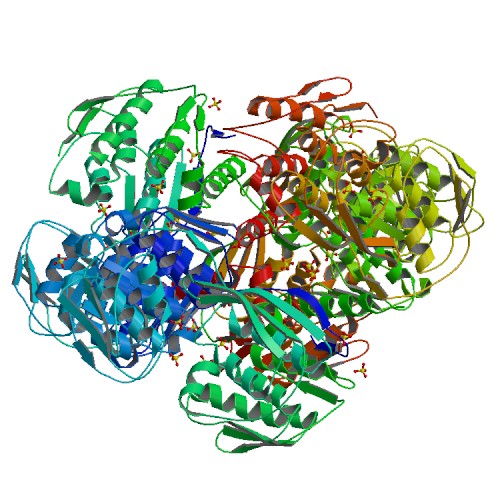Part:BBa_K2586007
aroA: 3-phosphoshikimate 1-carboxyvinyltransferase
This part encodes for the 3-phosphoshikimate 1-carboxyvinyltransferase.
The encoded enzyme is needed for the biosynthesis of essential aromatic amino acids in the shikimate pathway. Three essential aromatic amino acids are products of the pathway: Trp, Phe and Tyr. aroA is expressed in the E.coli wildtype.
aroA encodes the 5-enolpyruvylshikimate-3-phosphate (EPSP) synthase, which is the main target of the herbicide glyphosate and is strongly inhibited through glyphosate application. An amplification of aroE/aroA allows for glyphosate resistance (1), this is used in multiple GM plants to increase the yield and improve farming applications.
If exposed to glyphosate, E.coli mutants will make changes in the original sequence of aroA to avoid the lethal effects of the substance.
| Locus | BSU29750 |
| Isoelectric point | 5.34 |
| Molecular weight | 39.38 kDa |
| Protein length | 358 aa |
| Gene length | 1074 bp |
| Function | biosynthesis of aromatic amino acids |
| Product | 3-deoxy-D-arabino-heptulosonate 7-phosphate synthase/ chorismate mutase-isozyme 3 |
| Essential | no |
| Synonyms | aroG |
Sequence and Features
- 10COMPATIBLE WITH RFC[10]
- 12COMPATIBLE WITH RFC[12]
- 21COMPATIBLE WITH RFC[21]
- 23COMPATIBLE WITH RFC[23]
- 25INCOMPATIBLE WITH RFC[25]Illegal AgeI site found at 346
Illegal AgeI site found at 787 - 1000INCOMPATIBLE WITH RFC[1000]Illegal BsaI.rc site found at 1021
Characterization
aroE is essential in B. subtilis
As essential bacterial genes appear to be more conserved than nonessential genes, the aroE gene probably does not permit the accumulation of mutations, which can be beneficial (Jordan et al., 2002). To confirm that the aroE gene is indeed essential, we transformed the B. subtilis with a PCR product consisting of DNA fragments flanking the target gene and the intervening spc spectinomycin gene (aroE::spc deletion cassette) and propagated the bacteria on SP rich medium plates (see Notebook). Several tiny colonies appeared on the transformation plates after 24 h of incubation. However, the potential transformants were not viable and supplementation of the agar plates with casamino acids also did not improve growth of the bacteria. Thus, under the tested conditions aroE seems to be essential in B. subtilis. Next, we tested whether the chromosomal copy of the aroE gene becomes dispensable for the bacteria carrying an EPSP synthase gene on a plasmid. For this purpose, we transformed the B. subtilis wild type strain 168 with the plasmids pIGEM2 and pBP143 containing the aroE and aroA EPSP synthase genes from B. subtilis and E. coli, respectively. The wild type carrying the empty plasmid pBQ200 served as a control. Next, we transformed the three strains with the aroE::spc deletion cassette and with chromosomal DNA of strain BP233 (gltT::spc), of which the latter served as the positive control. While we did not get transformants without DNA, many transformants appeared with chromosomal DNA of strain BP233 (Figure X). Moreover, the chromosomal copy of the aroE gene was only dispensable in strains carrying an extra EPSP synthase gene on a plasmid. To conclude, the aroE EPSP synthase gene is essential in B. subtilis. Moreover, the bacteria seem to require the enzymatic function of the EPSP synthase because also the enzyme from E. coli permits growth of the aroE mutant
| protein |

